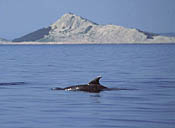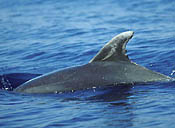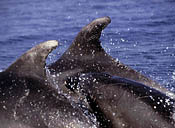|
Monk and Phil are also males that have been around the islands for many years. Blow was also often in the company of other known Lošinj dolphins - Freccia Bianca, Mirna, Paul, Squalo, Mida, Bik, Bianca...
Our last sighting of Blow was last summer, on the August 25, 2002 when he was in the company of 11 other dolphins, among whom were also Monk and Phil.
Bottlenose dolphins are the symbol of Lošinj and the Adriatic. Meeting them on the sea is unforgettable experience. Strength, beauty and intelligence radiate from them. To kill such animal is a crime. Blow was killed by an explosive charge. It is impossible to say if he was killed by chance during illegal fishing or was he killed intentionally. Since he is normally seen in large groups, there is a chance that other dolphins may have been injured, and are as yet to be discovered.
All whales and dolphins are protected in Croatia by Law on Nature Protection. Disturbing, chasing or killing them is a crime punishable with a 35.000kn (5.000Eu) fine. The Mali Lošinj Police Department has been informed of the crime and is currently investigating. The use of explosives for fishing is not only fatal for dolphin but also for divers. The pressure wave from an explosion underwater will kill everything within 100s of metres. Such actions can be stopped through public awareness and condemnation of the use of illegal fishing methods.
The Lošinj dolphin population is very small and the only known population in the Adriatic. Bottlenose dolphins are the last marine mammals in the Adriatic. Until recently common dolphins could be found in the Adriatic, however due to their sensitivity and inadaptability to rapid changes in the environment caused by human activities they have died out. Up to the 1960s dolphins were regarded as pests with a reward being paid for each tail the hunter bought in. During that period hundreds of, mostly common, dolphins were killed. Their number dramatically reduced and has never recovered. A fate similar to the monk seal. The common dolphin is now extinct in the northern Adriatic. Monk seal is also extinct in the Adriatic. Will the same fate fall on the bottlenose dolphin? Will the Adriatic become a "dead sea"?
The Blue World Institute of Marine Research and Conservation runs the ADP scientific, research and conservation project from Veli Lošinj. Our results gave us an insight into the ecology, biology and social relations of the Lošinj dolphins community. To further our conservation efforts we have proposed the establishment of the Lošinj dolphin reserve, the first dolphin reserve in the Mediterranean!
Our primary goal is to protect of the dolphin community, however, the reserve will also provide a way for the sustainable development of the Lošinj archipelago. Through careful planning, information sharing and the creation of partnerships between stakeholders - fisherman, tourist workers, divers, local government, biologists and others - this area will become a model of how protected area management can bring benefits and economic improvements to the local community.
Education and public awareness are the back bone for the effective management of the Lošinj dolphin reserve. To support this the Lošinj Marine Educational Centre will be completed this year with the help of the Mali Lošinj government. This will be the first education-interpretation centre about the sea on the Adriatic coast. The centre will be dedicated to the education of local and visiting people, with a small conference room and offices where specialist education programs will be held for particular interest groups.
Blue World Institute of Marine Research and Conservation is a non-profit organisation and all the funds necessary for it's work are acquired through donations and sponsorships by individuals and companies that wish to show their environmental commitment to us to the public. The funds we have are limited, and we use this opportunity to express our gratitude to our sponsors (Riva tours, HTcronet, GISData, City of Mali Lošinj, Principality of Monaco, Ministry of Environmental Protection and partners - Natura NGO and Croatian Natural History Museum) and to invite other potential sponsors and donators to contact us.
Lošinj dolphins and their environment need protection! By supporting Blue World you are helping to protect the Lošinj dolphins.
Top
|


